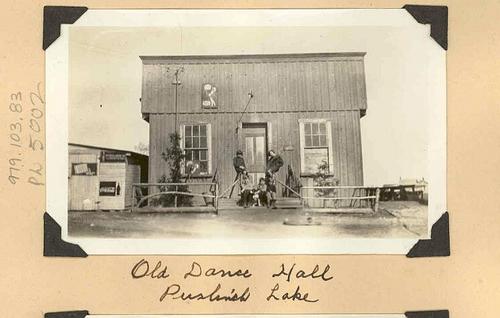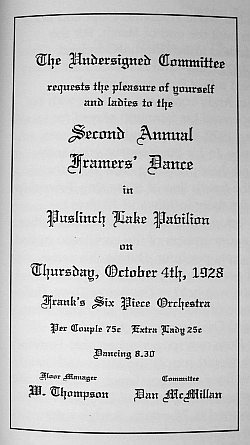History Corner: Dances At Puslinch Lake

The hotel at Puslinch Lake was, for a long time, a place for dancing but its heyday for this activity
was in the 1930’s. Stories have since circulated that Guy Lombardo and his Royal Canadians
played at the Lake. Although no evidence could be found to support that claim, it was possible to
find the names of other bands, which played there.
The grand opening of the new dance pavilion, built during 1927 at a cost of $5,000 to the City of
Guelph, owner of the resort at the time, was held on Thursday, May 24, 1928. Fair Pearse and his
orchestra played for dances in both the afternoon and the evening to capacity crowds, with many
people unable to get in. The hotel hall was draped in some 6,000 coloured streamers for the
event.
That was its official opening. It was completed in the fall of 1927, however and dances were held
in the new pavilion from late September 1927. Bruce McMillan’s orchestra played on September
30, the second evening.
In early August 1927, the Guelph City Council voted to build the combined boathouse/dance hall
at the Lakeview Inn and work was started at once. The structure hung over the water, with the
boathouse and change rooms for swimmers below and the dance hall above. As well as the
dance floor, there was a refreshment booth, ladies’ cloakroom and a smoking room for the
gentlemen. The entire building was surrounded with a verandah, accessed by French doors. In a
move calculated to economize, instead of installing a new floor, the dance floor from the previous
building was jacked up and moved onto the new foundation. The orchestra platform was in the
centre of the room. The structure was finished with stucco. The previous dance hall was
revamped into lavatories. In June 1928, the hotel on the property was re-wired.
In his book, Let’s Dance: A Celebration of Ontario’s Dance Halls and Summer Dance Pavilions,
Peter Young quoted Frank A. Smith, who said that, on Friday and Saturday evenings, women wore
long gowns and men dressed in suits. He recalled Merv Himes and his orchestra.
Fair Pearse was engaged to play on Monday, Wednesday and Friday evenings throughout the
summer of 1928. Franks’ Orchestra of Nassagaweya Township played for an “old time” dance on
Thursday evenings. According to Peter Young’s book, the Franks began in their Nassagaweya
locality and progressed to a weekly radio programme on CKOC in Hamilton in 1931, which led to
engagements in more distant centres in Southern Ontario. The advertising poster shown below is
from the book, The Bands Played On, Music and the Frank Family published in 1995 by Jean (née
Frank) Somerville, eldest daughter of Andy Frank.
In mid-May, the opening dance of the 1929 season featured Jack Slater and the Canadian Aces, a
9-piece orchestra with a singing trio. Three hundred couples swayed under red and blue
spotlights. Norm Brotherton and his Alexander Academy Orchestra from Hamilton played May
31st. The Puslinch Lake cottagers held at dance on June 5th, with music provided by the Monarch
Orchestra of Guelph. Snyder’s Orchestra played for an “old time” dance on Friday, June 14th, with
admission 70 cents per couple. On June 28th, it was a return engagement of Kalani and his
Orchestra of the Grange Café from Hamilton, which advertised, “Come and hear a real band.”
The Rich London Versatile Canadians played the July 1st holiday weekend. The midnight dance,
which began at midnight Sunday night, officially Monday, drew several hundred couples. On July
8th, the first cabaret night was held, with Rafferty, a member of the Dumbell Troupe entertaining, as
well as the Rich London Orchestra.
The United Farmers of Ontario held an old time dance in the new pavilion on Thursday, July 5th,
with an attendance of 340. The Puslinch Canoe and Boat Club, its home venue at Puslinch Lake,
held a weekly dance here.
The Canadian Ambassadors from Toronto supplied the music on Tuesday and Friday nights in
June 1930.
In the spring of 1931, the Lake View Hotel, under the new management of J. C. Bridges, who had
relocated from Edmonton, was advertising “good orchestral music each Wednesday and Friday”.
The place was painted, a new hardwood floor was laid throughout the building and the rear
portion of the dance pavilion was raised.
Frieland’s 10-piece Orchestra was playing Wednesday and Friday in the week of August 12, 1931;
on Thursday there was an “old tyme dance” with Frank’s Orchestra; and on Saturday, “jitney
dancing”. Jitney, a slang term, which came into use around 1910, referred to something done
cheaply. According to Peter Young, a jitney dance was one at which tickets could be purchased
inexpensively for individual dances, rather than paying a flat admission fee. After each number or
set, the floor would be cleared of all dancers and those who presented a ticket would glide on for
the next dance. A few fellows would be given free dance tickets in exchange for clearing the floor
each time. This was popular during the 1930’s and 40’s.
By May 1932, Lakeview offered dancing every evening. A report from Saturday, June 11th said:
“Over four hundred people from Hamilton, Kitchener, Galt, Guelph and Preston attended the
dance at Puslinch Lake last night, when Gene Fogarty’s Orchestra of Toronto provided excellent
music. Friday night dances at the Lake have been highly popular and crowds attending the
functions have been unusually large.”
The week of July 7, 1932 was the beginning of a regular Puslinch Lake camper’s and cottager’s
dance to be held every Tuesday evening.
Mr. Bridges remained until March 1933, when he sold to John Walsh of Puslinch, who placed Bill
Butler in charge. The dancing continued. Burn Knowles and his Country Club Orchestra were
engaged for May 31 and Friday, June 2, 1933, a “return engagement by popular request”.
Admission was $1. per couple.
There was dancing to Waldron’s Orchestra on July 2, 1934. Win Philip and his Chateau Laurier
Orchestra played a return engagement on a Friday in mid-July. The following evening, the
Ambassador 10-piece Cuban Orchestra featured tangos and rumbas; dancing from 8:30 to 12 at
an admission of 35 cents. Reg Freeland and his Collegians played for a midnight dance on Aug.
4th, from 12 to daylight, admission 40 cents and on the Aug. 6th Civic Holiday, from 9 to 1. The
Ambassadors played for a “midnight dance and frolic” on Labour Day, the last midnight dance of
the season.
The cottagers were still holding their dances in August 1936, when an orchestra from Galt played,
following a concert. An advertisement from July 25, 1939 for “get acquainted dances”, new at
Lakeview on Wednesday and Thursday nights, suggested “don your sports clothes, get out of
town, get acquainted or learn to dance” to Earl Porter’s Orchestra for 25 cents.
“Holiday dances” were held on Sat., June 29, 1940 and at midnight on June 30, both to the strains
of the Bob Donelle Orchestra, 50 cents each. The Little Holland Orchestra played on July 10th,
“ladies 25 cents, gents 35 cents”. Dancing was to the Al Kuhn Orchestra on July 17, 1941, to the
Irving Smuckler Orchestra on Aug. 9th and the Bob Donelle Orchestra was back again on Aug. 16th.
Subsequent orchestras were the Ted Parker Orchestra in 1941; the Dave Gray Orchestra from
Brantford and the Al Wagner Orchestra in 1942; the Douglas Hume Orchestra in 1943. Jean (née
McKay) Harnick recalls playing piano to accompany her father, Puslinch fiddler, Gordon McKay
for dances during these years.
Such was the dance band era at Puslinch Lake. The dance pavilion eventually became the Old
Marina Restaurant, where the circular ridge of the dance platform was still visible in the centre of
the floor. It burned to the ground on May 13, 2005.

